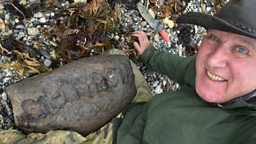Exploring the Jurassic seas with Sir David Attenborough
By Andre Rowe, paleobiologist at the University of Bristol

I went to Kimmeridge on a sunny day in May to surface scan the pliosaur skull discovered by Steve Etches and his crew. A significant portion of my PhD work involved using a portable surface scanner to create 3D models of carnivorous dinosaur skulls, including the famous tyrannosaurs, and studying their feeding biomechanics and behaviours. This involved traveling to museums in the US and UK.
Seeing the giant pliosaur skull in person for the first time was quite an experience.
Seeing the giant pliosaur skull in person for the first time was quite an experience. I have studied giant predatory fossil animals for years now, and yet I am still excited to see skulls that are longer than I am tall. The UK is great for marine reptile fossils and many palaeontologists and fossil enthusiasts will be aware of Mary Anning and the Jurassic Coast. I find marine reptiles like the pliosaurs fascinating, and I believe many palaeontologists like myself were interested in the Loch Ness Monster when we were much younger – the idea of these giant beasts still roaming the seas is tantalizing, though completely lacking in evidence.
The process of scanning the pliosaur skull was similar to scanning one of the usual giant dinosaur skulls. Generally, I scan different areas of the skull as different files due to large file sizes causing slowdown on the laptop; I then merge the different files later to reassemble the full skull.
From there, the Βι¶ΉΤΌΕΔ was able to 3D print the finalized computational model I made and even apply the correct colours to the skull! Additionally, my former PhD supervisor Emily Rayfield and I calculated a range of bite forces for the pliosaur based on muscle insertion points and probable sizes from the 3D model. Our upper range of values were in the ballpark of 33,000 Newtons, which overlaps with some lower estimates for Tyrannosaurus rex.

3D modelling of "a one in a billion" fossilised skull
Sir David Attenborough discusses a 3D model of a pliosaur skull with Dr Andre Rowe.
During the filming, Sir David Attenborough and I discussed the process of scanning the skull and manipulating the 3D on my laptop screen. He seemed impressed by the fact that I was able to preserve such fine details of the skull in the 3D model, such as the bone textures.
such a massive animal with powerful jaws would have surely dominated its ecosystem
We talked about the extraordinary jaw muscles the animal would have had, and its implications for the pliosaur’s lifestyle. Essentially, such a massive animal with powerful jaws would have surely dominated its ecosystem; hence, I refer to the pliosaur as the marine equivalent of a gigantic tyrannosaur, likely preying on other large animals in addition to small invertebrates.
Finally, David inquired about the hypothetical fight between a giant pliosaur and a Tyrannosaurus. I replied that my beloved T. rex would be unlikely to win such a battle due to the watery environment, and such a scenario would bring me to tears (I really, really like T. rex – it was my first tattoo and covers my inner right arm). He was certainly amused by my answer. Much like my T. rex, Sir David is an incredible figure in natural history and he certainly lives up to his reputation.




